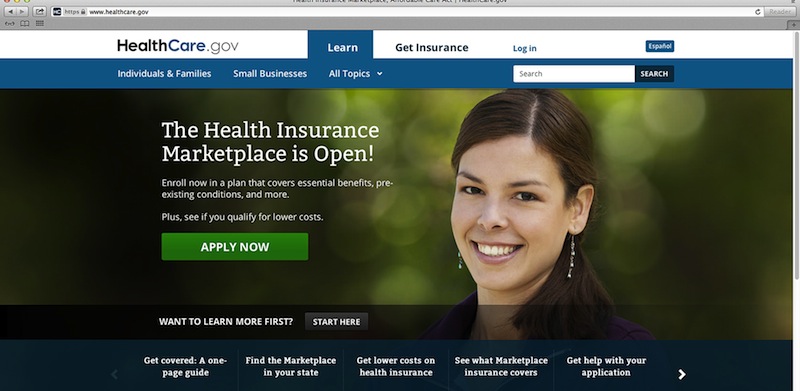The glitch-ridden rollout of President Barack Obama’s health care law has opponents crowing: “Told you so!” and insisting it should be paused, if not scrapped.
But others, including insurance companies, say there’s still enough time to fix the online enrollment system before uninsured Americans start getting coverage on Jan. 1.
After emergency repairs over the weekend, consumers in different parts of the country Monday continued to report delays on healthcare.gov, as well as problems setting up security questions for their accounts. The administration says the site’s crowded electronic “waiting room” is thinning out. Still, officials announced it will be down again for a few hours starting at 1 a.m. Tuesday for more upgrades and fixes.
Despite the confusion, the insurance industry has held off public criticism. Alarmed that only a trickle of customers got through initially, insurers now say enrollments are starting to come in and they expect things to improve.
The last major federal health care launch — the Medicare prescription program in 2006 — also had big startup problems. Government leaders who oversaw it say things could look very different in a couple of months for Obama’s law if the administration manages to get a grip on the situation.
“There wasn’t enough time for testing, so the dress rehearsal became opening night,” said Michael Leavitt, who as President George W. Bush’s top health official, was responsible for the Medicare drug plan debut.
“The moment of truth is going to come in the middle of November, when people want to see the real deal,” said Leavitt, who currently heads a consulting firm that advises states on the health overhaul. “If they don’t have this running smoothly by then, it’s going to be a bigger problem than we’re seeing today.”
The insurance industry is calling for patience. “This is a marathon and not a sprint,” Karen Ignagni, head of the trade group America’s Health Insurance Plans, said in a statement. “We anticipate enrollments will continue to increase in the days and weeks ahead.”
Obama’s law — also known as the Affordable Care Act — was designed to provide insurance for people who don’t have access to coverage on the job. Middle-class uninsured people can buy a government-subsidized private plan, while the poor and near-poor will be steered to Medicaid in states that agree to expand the safety net program. The online insurance markets were envisioned as the 21st century portal to an overhauled system.
But when the health care markets went live last week, millions of curious Americans overwhelmed federal and state insurance websites. The level of interest could be read as a good sign, since polls just prior to the launch found most uninsured people unaware it was coming. Yet for many, the consumer experience was like a Saturday morning spent twiddling thumbs at the local motor vehicle department.
Some prospective customers got a screen that told them to wait — and nothing happened, for hours. Others started to sign up and got trapped by a recurring glitch when they tried to set up security questions to protect their personal accounts. Some who got through all the way to the end found their sessions had timed out, and they had to start over.
The federal website that serves 36 states wasn’t the only problem; several states also had a rough launch. As Republicans opposed to “Obamacare” showed they were willing to shut down the government in an effort to stop it, the administration seemed to be its own worst enemy.
Technology experts say the problems are probably due to a combination of factors: unexpectedly high demand, as well as possible software flaws and shortcomings in design. Sometimes a high volume of users can expose software problems that went undetected in testing, they said.
The administration has mainly blamed high volume. The Health and Human Services department says it is adding servers —workhorse computer equipment — to the system to handle the volume of user requests.
Official media releases have hinted at software and system design problems, without providing detail. For example, one referred to procuring “dedicated hardware” for an unnamed “specific component of the system that became over-stressed.”
Problems caused by website overload should ease as more equipment is added. Software and design flaws are trickier to fix, meaning more overnight repairs.
Monday, White House spokesman Jay Carney said officials would not release enrollment data on an “hourly or daily or weekly basis,” although outside experts say the administration is certain to have those numbers. Officials regularly report the number of unique visitors to healthcare.gov — they just don’t say how many get to the end of the application. Those numbers will be released at “regular monthly intervals,” Carney said.
Mark McClellan, who ran Medicare during the bumpy prescription program rollout in 2006, said during that time he had detailed daily tracking stats, and he’s sure the Obama administration must have at least the same level of information.
“I would think they have a good handle not only on enrollment, but on each step of the process where the drop-offs are occurring,” McClellan said. “If you aren’t tracking those kinds of performance metrics for the system in close to real time, it’s awfully hard to figure what’s wrong in order to fix it.”
Now a health policy expert with the nonpartisan Brookings Institution, McClellan says the message for consumers is, “take a deep breath. If you are interested in this program, you do not need to make a decision this week, or even this month. You should make a decision by November. Given the issues a lot of people are having, that’s probably a good reason to wait.”
Send questions/comments to the editors.


